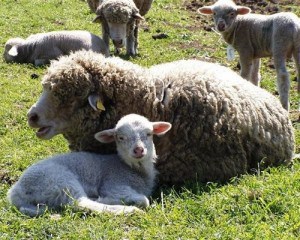
In this blog series, Molly will be (virtually) traveling around the globe to explore the way cheeses are enjoyed and incorporated into different cuisines. Some of these cheeses and methods might seem familiar, while others might be completely new to you. Last week we talked about France. Kevin was the winner of a free issue of culture – read on to find out how you can win a copy, too! Get more stamps on your cheese passport and join us for a historical and cultural adventure!
I have to admit, I have a soft spot for Italy and its cheeses. One of my favorite cheese memories involves eating a knot of Mozzarella di Bufala like an apple, standing on the side of the road in a small town in southern Italy with my high school classmates on a hot June day. As a college student in a study abroad program, I lived with an Italian family, and a typical dinner of spaghetti with a light cherry tomato sauce always included a shaving of peppery Pecorino Romano. During my stint working at an Italian wine bar, my favorite staff meal was pasta with peas and creamy Gorgonzola sauce.
Italian cheese culture stretches far beyond the melted mozzarella on pizza or the provolone on a sandwich. Just like in France, the cheese tradition of Italy is tied to the geography, history, and culture of the country. Remember that France produces at least 350 to 400 distinct varieties of cheese, though it’s probably more like 1000? Italy has that number matched, if not beat. Italians are a proud group, and this pride for their cheesemaking traditions is what allows so many different types of cheese to survive when they otherwise might be lost.
Sheep are essential to these traditions. These animals are better suited than cows to the dry and rocky climates of central and southern Italy. Pecora means sheep, which is why many Italian cheeses are called pecorinos, most of which are produced in the regions of Lombardy, Lazio, Sicily, and Sardinia. These animals not only provide milk, but also wool, meat, pelts, and oil that can be turned into soap and candles, making them an economical choice for farmers. Unlike cows, sheep can forage and require little shelter to survive.

Sopravissana sheep, from the Latium (Lazio) region of Italy | Photo Credit: Image courtesy of www.agraria.org
Italians are fiercely regional in their identity and the cheeses they produce. A latteria (dairy or creamery) in Tuscany probably won’t be selling any cheeses made in Sicily or Lombardy. A visit to an Italian cheese shop will give you a great glimpse of the cheeses the people in that region or village eat and make. Cheeses are typically named after their place of production or the type of milk or technique used rather than a specific producer.
Cheesemaking and cheese consumption in the country dates back to before the Roman Empire. Marcus Apicius, reputed to be the author of the oldest cookbook in the world, wrote extensively about the place of cheese in the Roman diet and recipes. Cheesy recipes in the Apicius cookbook range from the very simple Mel et Caseum (cheese and honey) to the slightly more complicated Tyrotarica, a dish best described as fish gratin that uses salt fish, chicken livers, and melted cheese. I don’t think I’ll be trying that one anytime soon!

Apicius manuscript from a monastery in Germany. | Photo Credit: Image courtesy of the New York Academy of Medicine
The fact that many recipes in this text – dating back to the 4th or 5th century – call for cheese explains why it is such an important ingredient in Italian cooking. A simple dish such as fava beans and Pecorino Toscano is a perfectly acceptable springtime meal that showcases the flavor of the cheese, while Sheep’s Milk Ricotta Gnudi is a more involved recipe that relies on cheese as the backbone for the gnudi (a pasta related to gnocchi).
I don’t know about you, but after all this talk of Italian cheese, I’m craving a Caprese Salad!
What’s your favorite type of Italian cheese? Have a favorite Italian dish? Do you plan to try any of the recipes from Apicius? Tell us about it in the comments below for a chance to win a copy of our summer issue! Comments must be posted by 11:59 p.m. EDT on Tuesday, July 15, 2014 to be eligible to win. So comment today and stay tuned for next week’s post! And don’t forget to tune in next week when we travel to the Netherlands.
Photo Credit: Aging Parmesan Cheese from Crystal Kitchen



Trentino and Südtirol/Alto Adige are sadly often overlooked cheese and dairy dynamos by many outside of Central Europe. Some of the cheeses are only made with milk from cows that graze on high elevation pastures in the summer, called malga (or malghe). This also takes place in neighboring Lombardia as well. One of the best known malga cheeses is from a commune called Vezzena not far from Trento. Vezzena DOP is one of my favorite firm mountain cheeses because it has a fantastic lingering fruity aftertaste and a meaty flavor. It used to be a favorite table cheese of Austrian Emperor Franz Josef I and his court until the First World War. Another unique malga cheese is called Puzzone di Moena (the ‘stinky one’ of Moena), which is from the area surrounding the Ladin-speaking town of the same name in the Val di Fassa. This is a ~25 lb semi-firm medium wheel with a rusty red washed rind, and with a penetrating but complex smell. It is fantastic for melting and lends a unique tangy and piquant flavor with a pastoral, yeasty aroma not unlike Taleggio.
Südtirol is well known for its alpine cheeses which are used in lieu of similar cheeses from neighboring regions, but also for Stelvio (Stilfser in German), a smooth semi-firm “just pungent enough” slicing and melting cheese. This cheese is truly special as it pairs perfectly with Südtiroler Speck, a lightly smoked prosciutto that is an icon of the region. To take advantage of the great deal of wine production here, a number of different cheeses soaked in wine and local herbs are made called Weinkäse. The best are those that have allowed a grey mold to create a natural edible rind on the wheels. Some almost taste like a springy salame.
I was just in Trentino/Südtirol-Alto Adige last December and I can’t wait to go back, even if its just to nosh on local cheeses.
Wow, thanks for all the great info! I also want to return to Italy soon, mostly to eat some more local cheese.
Taleggio is my “desert island” cheese. If I had only one cheese to choose for the rest of my life, that would be it. It makes the best grilled cheese, add it to pasta and it turns into it’s own sauce, use in a lasagna, makes a great mac and cheese or just spread on a cracker or crusty bread. The everything cheese.
I love the idea of desert island cheese! It’s a great conversation starter.
Love me some Piave and Taleggio.
Both delicious choices!